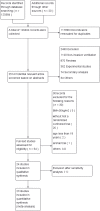Optimized ventilation strategy for surgery on patients with obesity from the perspective of lung protection: A network meta-analysis
- PMID: 36330511
- PMCID: PMC9623268
- DOI: 10.3389/fimmu.2022.1032783
Optimized ventilation strategy for surgery on patients with obesity from the perspective of lung protection: A network meta-analysis
Abstract
Objectives: New ventilation modes have been proposed to support the perioperative treatment of patients with obesity, but there is a lack of consensus regarding the optimal strategy. Therefore, a network meta-analysis update of 13 ventilation strategies was conducted to determine the optimal mode of mechanical ventilation as a protective ventilation strategy decreases pulmonary atelectasis caused by inflammation.
Methods: The following databases were searched: MEDLINE; Cochrane Library; Embase; CINAHL; Google Scholar; and Web of Science for randomized controlled trials of mechanical ventilation in patients with obesity published up to May 1, 2022.
Results: Volume-controlled ventilation with individualized positive end-expiratory pressure and a recruitment maneuver (VCV+PEEPind+RM) was found to be the most effective strategy for improving ratio of the arterial O2 partial pressure to the inspiratory O2 concentration (PaO2/FiO2), and superior to pressure-controlled ventilation (PCV), volume-controlled ventilation (VCV), volume-controlled ventilation with recruitment maneuver (VCV+RM), volume-controlled ventilation with low positive end-expiratory pressure (VCV+lowPEEP), volume-controlled ventilation with lower positive expiratory end pressure (PEEP) and recruitment maneuver (VCV+lowPEEP+RM), and the mean difference [MD], the 95% confidence intervals [CIs] and [quality of evidence] were: 162.19 [32.94, 291.45] [very low]; 180.74 [59.22, 302.27] [low]; 171.07 [40.60, 301.54] [very low]; 135.14 [36.10, 234.18] [low]; and 139.21 [27.08, 251.34] [very low]. Surface under the cumulative ranking curve (SUCRA) value showed VCV+PEEPind+RM was the best strategy for improving PaO2/FiO2 (SUCRA: 0.963). VCV with high positive PEEP and recruitment maneuver (VCV+highPEEP+RM) was more effective in decreasing postoperative pulmonary atelectasis than the VCV+lowPEEP+RM strategy. It was found that volume-controlled ventilation with high positive expiratory end pressure (VCV+highPEEP), risk ratio [RR] [95% CIs] and [quality of evidence], 0.56 [0.38, 0.81] [moderate], 0.56 [0.34, 0.92] [moderate]. SUCRA value ranked VCV+highPEEP+RM the best strategy for improving postoperative pulmonary atelectasis intervention (SUCRA: 0.933). It should be noted that the quality of evidence was in all cases very low or only moderate.
Conclusions: This research suggests that VCV+PEEPind+RM is the optimal ventilation strategy for patients with obesity and is more effective in increasing PaO2/FiO2, improving lung compliance, and among the five ventilation strategies for postoperative atelectasis, VCV+highPEEP+RM had the greatest potential to reduce atelectasis caused by inflammation.
Systematic review registration: https://www.crd.york.ac.uk/PROSPERO/, identifier CRD42021288941.
Keywords: immune response; inflammation; intraoperative ventilation strategy; obesity; pulmonary atelectasis.
Copyright © 2022 Wang, Zeng, Zhang, Zheng, Huang, Zhao, Duan and Yu.
Conflict of interest statement
The authors declare that the research was conducted in the absence of any commercial or financial relationships that could be construed as a potential conflict of interest.
Figures






References
Publication types
MeSH terms
LinkOut - more resources
Full Text Sources
Medical

